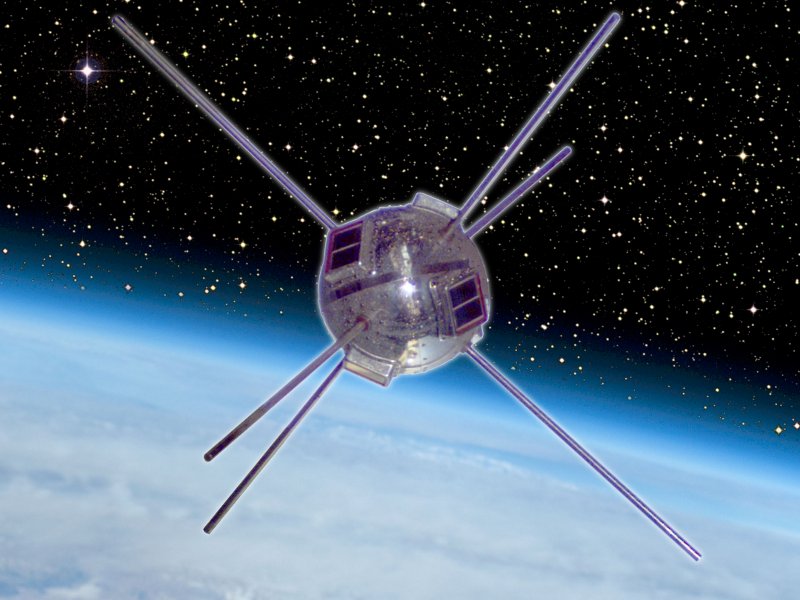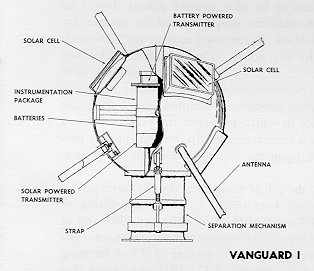
Vanguard 1 satellite (NASA)
Composite illustration assembled from static display of satellite, Earth from orbit and telescope photo of stars.
On March 17, 1958, Vanguard 1, the fourth artificial Earth orbital satellite was launched, which was the first solar-powered satellite. Although communication with it was lost in 1964, it remains the oldest manmade satellite still in orbit. It was designed to test the launch capabilities of a three-stage launch vehicle as a part of Project Vanguard, and the effects of the environment on a satellite and its systems in Earth orbit. It also was used to obtain geodetic measurements through orbit analysis.
Transmitting Signals for Seven Years
Vanguard 1 was placed into orbit on March 17, 1958. It is the fourth artificial satellite and the first spacecraft to use solar cells for power supply. Vanguard 1 was placed on an elliptical orbit with a lowest point of 650 km and a highest of 4,000 km, inclined at about 35° to the equator. Original estimates had the orbit lasting for 2,000 years. However, it was discovered that solar radiation pressure and atmospheric drag during high levels of solar activity produced significant perturbations in the perigee height of the satellite, which caused a significant decrease in its expected lifetime to only about 240 years. and that the satellite will enter the Earth’s atmosphere around the year 2200. Vanguard 1 transmitted its signals for nearly 7 years as it orbited the Earth.

Vanguard 1 satellite sketch
The Asymmetrical Shape of the Earth
Vanguard 1 was built by the Naval Research Laboratory (NRL) and is tiny compared to Sputnik 1.[4] After the failed launch attempts of Vanguard TV3 and Vanguard TV3BU, the Naval Research Laboratory ventured another launch. This was also successful. Vanguard 1 was launched on 17 March 1958 with the three-stage Vanguard launcher with serial number TV4 (Test Vehicle 4) from the Cape Canaveral spaceport in Florida into medium earth orbit (MEO). As a result of the project, it was found that the shape of the Earth has a slight north-south asymmetry, occasionally described as pear-shaped with the stem at the North Pole. With the help of radio signals, the total electron content between the satellite and selected ground-receiving stations were determined. The last signals were received at Quito, Ecuador in May 1964 after which the spacecraft was optically tracked from Earth. Vanguard 1 was also used by the researchers for determining upper atmospheric densities as a function of altitude, latitude, season, and solar activity.
Longer in Space than any other Satellite
Prior to launch, the Initial Naval Research Laboratory’s proposals included conical satellite bodies. This eliminated the need for a separate fairing and ejection mechanisms, and their associated weight and failure modes. Radio tracking would then gather data and establish a position. Early in the program, optical tracking was also added. A panel of scientists proposed changing the design to spheres, at least twenty inches in diameter . A sphere would have a constant optical reflection, and constant coefficient of drag, based on size alone, while a cone would have properties that varied with its orientation. Since three of the Vanguard satellites are still orbiting in the 2010s, with their drag properties essentially unchanged, they form a baseline data set on the atmosphere of Earth that is over 50 years old and continuing. On March 17, 2008, Vanguard 1 logged its 50th year in Earth orbit. It holds the record for being in space longer than any other man-made object.
Lawrence L. Kazmerski, First Solar Powered U.S. Satellite 1958 – Project Vanguard, [6]
References and Further Reading:
- [1] Vanguard I the World’s Oldest Satellite Still in Orbit
- [2] Vanguard Approaches Half A Century In Space
- [3] Vanguard 1 at Smithsonian
- [4] The Sputnik Shock and the Start of the Space Race, SciHi Blog
- [5] Vanguard 1 at Wikidata
- [6] Lawrence L. Kazmerski, First Solar Powered U.S. Satellite 1958 – Project Vanguard, EdisonTechCenter @ youtuibe
- [7] Timeline of Earth’s artificial satellites, via Wikidata





